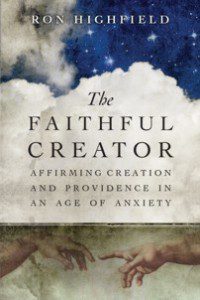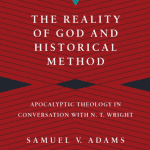 The first chapter of Ron Highfield’s new book The Faithful Creator: Affirming Creation and Providence in an Age of Anxiety looked at the theology of creation in the Old Testament. A commenter on A Theology of Creation suggested that this was the wrong place to start. As Christians our understanding of Christ should shape our theology of creation. Irrespective of the disagreement over the correct starting place, Highfield (and I) certainly agree that Christ shapes our theology of creation. The second chapter of Highfield’s book looks at the New Testament theology of creation – In the beginning was the Word.
The first chapter of Ron Highfield’s new book The Faithful Creator: Affirming Creation and Providence in an Age of Anxiety looked at the theology of creation in the Old Testament. A commenter on A Theology of Creation suggested that this was the wrong place to start. As Christians our understanding of Christ should shape our theology of creation. Irrespective of the disagreement over the correct starting place, Highfield (and I) certainly agree that Christ shapes our theology of creation. The second chapter of Highfield’s book looks at the New Testament theology of creation – In the beginning was the Word.
Highfield identified five theses concerning creation in the Old Testament. All five of these are also affirmed in the New Testament.
- The one God is the absolute origin and sovereign ruler over all that is not God. The doxology at the end of Romans 11 provides one example: “For from him and through him and for him are all things.”
- The one God freely established the Creator-creature relation, which is characterized by generosity, freedom, and power on the Creator’s side and dependence and debt on the creature’s side. On this one Highfield references Acts 17:28 and Romans 9:20. He could also reference Romans 11 again (although he doesn’t).
- The creation really exists before God and stands before him as good; that is, as the result of God’s act of creation, the creature is really what God intended it to be and can be used for the purpose God intended. A number of NT passages refer to all that God has created as good including 1 Tim. 4:4 and 1 Cor. 10:25-26.
- The Creator-creature relation established at the beginning, with its characteristic qualities, endures for all time. Revelation 4:11 provides an example: You are worthy, our Lord and God, to receive glory and honor and power, for you created all things, and by your will they were created and have their being.
- Human beings possess a unique relationship to the Creator characterized by their image and likeness to God and responsibility to him. Many passages could be cited. The parables in Luke 15 of the lost coin, lost sheep, and lost son provide a powerful example. So to does John 3:16-17.
Christ and Creation. However, these five theses only set the stage for a New Testament theology of creation. More important is the role of Christ as Creator. Highfield identifies four specific christological creation texts. John 1-5, 10-14; 1 Cor. 8:4-6; Col. 1:15-20; and Hebrews 1:1-4. All four of these identify the creator as the father of the Lord Jesus the Christ. They also (although Highfield doesn’t include this in his summary) highlight creation as in, through, and for Jesus the Christ. (I’ve taken the passages from the NRSV.)
John 1:1-5, 14:
In the beginning was the Word, and the Word was with God, and the Word was God. He was in the beginning with God. All things came into being through him, and without him not one thing came into being. What has come into being in him was life, and the life was the light of all people. …And the Word became flesh and lived among us, and we have seen his glory, the glory as of a father’s only son, full of grace and truth. The light shines in the darkness, and the darkness did not overcome it.
This is a key creation passage – perhaps the key New Testament passage. “The Word through whom salvation comes is the means, the instrument through whom God created all things and in whom all things live.” (p. 45) There are four assertions about the Word. (1) The Word was in the beginning. (2) The Word was with God – indicating “a distinction of some kind from God (ho theos).” (p. 46) (3) The Word was God. John 1:1 has “καὶ ὁ λόγος ἦν πρὸς τὸν θεόν, καὶ θεὸς ἦν ὁ λόγος.” Highfield notes that the last reference, καὶ θεὸς, does not contain the article. This gives a slightly different meaning than often inferred from the English translation – the Word was divinity with the God in the beginning. (4) Not content to rest with this John combines 1 and 2 – He (the Word) was in the beginning with God.
Highfield next looks at the relationship of the Word to creation “All things came into being through him …”. His view is somewhat more indirect than I would suppose. ““God” (ho theos) is the implied subject of this sentence, and the Word is the instrument through which God created all things.” (p. 46) For Highfield John attests to Christ as God’s instrument – a reading that seems to derive from a prior commitment and other New Testament references rather than the text of John itself. At any rate, everything comes to be through “the creative agency of the Word.” It is also possible to make a connection between Christ as the light of all people and Genesis 1:3 Then God said, “Let there be light”; and there was light. John blends two meanings of the word light – physical light and enlightenment.
1 Corinthians 8:4-6
Hence, as to the eating of food offered to idols, we know that “no idol in the world really exists,” and that “there is no God but one.” Indeed, even though there may be so-called gods in heaven or on earth—as in fact there are many gods and many lords— yet for us there is one God, the Father, from whom are all things and for whom we exist, and one Lord, Jesus Christ, through whom are all things and through whom we exist.
Highfield works through the entire passage, but he last verse hits on the point we want to emphasize. God is the one from who all things are and for whom we exist. Here the agency of Christ is clear – he is the one through whom all things are and through whom we exist. God is the Creator, Christ is the agent of creation.
And in that reversal Paul calls for a dramatic shift in the way we understand creation, salvation and ethics. Everything – God and creation, beginning and end, salvation and damnation – must be understood in view of the life, death, and resurrection of Jesus Christ. (p. 51)
Colossians 1:15-20
He is the image of the invisible God, the firstborn of all creation; for in him all things in heaven and on earth were created, things visible and invisible, whether thrones or dominions or rulers or powers—all things have been created through him and for him. He himself is before all things, and in him all things hold together. … and through him God was pleased to reconcile to himself all things, whether on earth or in heaven, by making peace through the blood of his cross.
Highfield notes that the two qualifiers image and firstborn are significant. “These two qualifications indicate a close ontological relationship between the Son and the Father and an ontological gulf between the Son and creation.” (p. 52) The image is the revelation of God (the invisible God). See also 2 Cor. 4:4. The designation firstborn of all creation needs more discussion.
Designating the Son as the “firstborn” (prōtotokos) over creation indicates not that he is the chronologically first creature but that he is superior in rank to all creatures. According to McDonough [Christ as Creator p. 185] the title “firstborn” may “speak of an inextricable link between Messiah and creation. … He was always its intended ruler. It was made for his purposes according to his specifications.
The end of the passage, with God making peace through the blood of his cross, connects salvation and creation. Salvation through Christ fulfills what was from the beginning.
Hebrews 1:1-4
Long ago God spoke to our ancestors in many and various ways by the prophets, but in these last days he has spoken to us by a Son, whom he appointed heir of all things, through whom he also created the worlds. He is the reflection of God’s glory and the exact imprint of God’s very being, and he sustains all things by his powerful word. When he had made purification for sins, he sat down at the right hand of the Majesty on high, having become as much superior to angels as the name he has inherited is more excellent than theirs.
It is the Son through whom God created all things He is the reflection of God’s glory and the exact imprint of God’s very being. Hard to get much stronger than this. It is through the Son that we know God.
Highfield concludes the chapter by summarizing:
As these four texts witness, the New Testament identifies the Creator as the Father of the Lord Jesus Christ. The One revealed in the life, teaching, death, and resurrection of Jesus is the Creator of heaven and earth. This identification not only highlights the universal significance of the work of Jesus Christ but also sheds new light on the character and purpose of creation. The divine act of creation anticipates and prepares the way for the divine act of salvation through Jesus Christ. The New Testament brings the biblical themes of creation and salvation into new intimacy. In Jesus Christ we see the revelation of the Jesus-character of creation and the Creator-character of salvation. (p. 55)
All four passages witness to Christ as the one through whom and for whom creation exists. They tie together salvation and creation. Highfield doesn’t go here in this chapter, but in my reading this is not entirely consistent with the view of Christ as the solution of a man-made problem. We see a sweep of scripture that includes creation, fall, and redemption, but not a storyline that envisions God fixing something that went astray from his original plan. Christ was always the intended king and salvation though Christ fulfills what was always intended from the beginning.
How do these New Testament passages shape your view of creation?
Has Highfield left out anything important?
If you wish to contact me directly you may do so at rjs4mail[at]att.net.
If interested you can subscribe to a full text feed of my posts at Musings on Science and Theology.
















